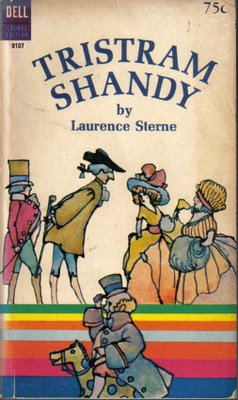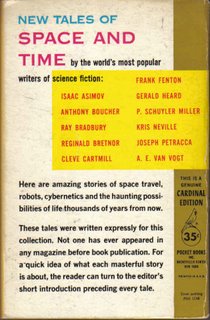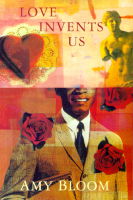 In other news, I'm going to take off for about a week to Washington DC for a big archives conference. My access to the compubots will be severely limited, so you will have to make up your own Spacebeer posts until I get back.
In other news, I'm going to take off for about a week to Washington DC for a big archives conference. My access to the compubots will be severely limited, so you will have to make up your own Spacebeer posts until I get back.Dig.
 I know you have all been wondering what on earth I've been doing with myself, reading-wise. It has been over a week since I posted about a book, and I had to be busy reading something right? Right indeed. What kept me so busy was the rambling comedic novel from the mid-1700s (originally published between 1759 and 1767 to be exact), The Life and Opinions of Tristram Shandy, Gentleman by Laurence Sterne.
I know you have all been wondering what on earth I've been doing with myself, reading-wise. It has been over a week since I posted about a book, and I had to be busy reading something right? Right indeed. What kept me so busy was the rambling comedic novel from the mid-1700s (originally published between 1759 and 1767 to be exact), The Life and Opinions of Tristram Shandy, Gentleman by Laurence Sterne. 1970s [?] Kleer-Vu Report Cover packaging, for your viewing enjoyment. It is hard to see on this scan, but the model's undereye circles are very strange when you see the sheet in person. It is almost like they were drawn in. As if to show that the power of the Kleer-Vue Report Cover ("No paper punching required!") is that you can procrastinate, go out every night, pull an all-nighter the day before the assignment is due, and your report will still look professional and neat in the morning.
1970s [?] Kleer-Vu Report Cover packaging, for your viewing enjoyment. It is hard to see on this scan, but the model's undereye circles are very strange when you see the sheet in person. It is almost like they were drawn in. As if to show that the power of the Kleer-Vue Report Cover ("No paper punching required!") is that you can procrastinate, go out every night, pull an all-nighter the day before the assignment is due, and your report will still look professional and neat in the morning.
 Josh and I were having a discussion this weekend about recurring dreams we had when we were little kids. The only one I could remember was this kind of strange dream from when I was three or four where I was standing in a cul-de-sac in some strange neighborhood and this little boy was riding a tricycle around the circle. We wouldn't say anything, I'’d just watch him ride for awhile and then wake up. I remember having that dream a bunch of times in a row.
Josh and I were having a discussion this weekend about recurring dreams we had when we were little kids. The only one I could remember was this kind of strange dream from when I was three or four where I was standing in a cul-de-sac in some strange neighborhood and this little boy was riding a tricycle around the circle. We wouldn't say anything, I'’d just watch him ride for awhile and then wake up. I remember having that dream a bunch of times in a row. I'm trying to get my head around the seemingly-sudden onslaught of businesses using this poorly photographed Open sign (and I am way too lazy to walk down the street and take a non-out-the-car-window super-zoomed-moving picture of it, so just squint your eyes a bit and you'll get the idea). I noticed the sign one day at the convenience store by my house. A bit later, the same sign showed up at Toy Joy. Then the sign appeared on the slightly creepy Sno-Cone stand in the parking lot of a pawn shop on Guadalupe. It also graces the front of the new location of The Parlor on Guadalupe. Finally, it is on some new restaurant called something like Moe's Southwest Grill down by campus (sadly, not pictured -- oncoming traffic got in the way of my car window shot). Was there some kind of super discount on this sign? Did a door-to-door sign salesman hit up all the businesses in my area? Are these signs actually aliens that are going to take over the planet from store-front windows?
I'm trying to get my head around the seemingly-sudden onslaught of businesses using this poorly photographed Open sign (and I am way too lazy to walk down the street and take a non-out-the-car-window super-zoomed-moving picture of it, so just squint your eyes a bit and you'll get the idea). I noticed the sign one day at the convenience store by my house. A bit later, the same sign showed up at Toy Joy. Then the sign appeared on the slightly creepy Sno-Cone stand in the parking lot of a pawn shop on Guadalupe. It also graces the front of the new location of The Parlor on Guadalupe. Finally, it is on some new restaurant called something like Moe's Southwest Grill down by campus (sadly, not pictured -- oncoming traffic got in the way of my car window shot). Was there some kind of super discount on this sign? Did a door-to-door sign salesman hit up all the businesses in my area? Are these signs actually aliens that are going to take over the planet from store-front windows? Oddly enough, I seriously just spent 20 minutes searching on the Internet for a site that sells this particular type of open sign and I could not find a single one. Tons of shops sell another popular Open Sign in my neighborhood (pictured at right). It is sometimes known as the "Disco Swirl" and sometimes as the "Economy Open Sign." So why can't I find the green oval beauty? Where are they all coming from? How many more of them are there?
Oddly enough, I seriously just spent 20 minutes searching on the Internet for a site that sells this particular type of open sign and I could not find a single one. Tons of shops sell another popular Open Sign in my neighborhood (pictured at right). It is sometimes known as the "Disco Swirl" and sometimes as the "Economy Open Sign." So why can't I find the green oval beauty? Where are they all coming from? How many more of them are there? One chore I really really really hate doing is washing my car. The automatic car washes kind of freak me out, and I can never build up the energy to drive six blocks to the self-serve car wash in our neighborhood, find eight quarters, and wash it myself. I like to think that if I had a house and a driveway, I would be better about washing my car, but honestly, I don't think I would.
One chore I really really really hate doing is washing my car. The automatic car washes kind of freak me out, and I can never build up the energy to drive six blocks to the self-serve car wash in our neighborhood, find eight quarters, and wash it myself. I like to think that if I had a house and a driveway, I would be better about washing my car, but honestly, I don't think I would. I found this part of an article (click to make it bigger) from the April 23, 1961 Durham Morning Herald in one of my math collections (on the other side was a "lifestyle" article about a female physicist that basically contained a series of exclamations along the lines of: "She is a theoretical physicist -- and she has four kids!" "She is just a regular housewife -- who does math all day!" and "She explores the secrets of the universe -- and the secrets of a perfect roast chicken!" It also included both a picture of her at a desk doing physics work and one of her getting a facial. Real hard-hitting stuff.)
I found this part of an article (click to make it bigger) from the April 23, 1961 Durham Morning Herald in one of my math collections (on the other side was a "lifestyle" article about a female physicist that basically contained a series of exclamations along the lines of: "She is a theoretical physicist -- and she has four kids!" "She is just a regular housewife -- who does math all day!" and "She explores the secrets of the universe -- and the secrets of a perfect roast chicken!" It also included both a picture of her at a desk doing physics work and one of her getting a facial. Real hard-hitting stuff.) For Josh's birthday, I bought him half of the lovely new TV pictured here and he graciously threw in on the other half. Since our old TV was a present on his 19th birthday, and he turned 29 this weekend, this new one is much deserved. Not only are we moving from a 19 inch screen to a glorious 27 inches, but we also now receive more than just Fox on our TV. And since it somehow picks up digital signals through the antenna (I don't understand technology) we have inherited an additional PBS. Two PBS's! Awesome! Still no cable, but enlarging our selection from one channel to eight will really make a difference when NASCAR is on Fox and we want to watch TV while we eat.
For Josh's birthday, I bought him half of the lovely new TV pictured here and he graciously threw in on the other half. Since our old TV was a present on his 19th birthday, and he turned 29 this weekend, this new one is much deserved. Not only are we moving from a 19 inch screen to a glorious 27 inches, but we also now receive more than just Fox on our TV. And since it somehow picks up digital signals through the antenna (I don't understand technology) we have inherited an additional PBS. Two PBS's! Awesome! Still no cable, but enlarging our selection from one channel to eight will really make a difference when NASCAR is on Fox and we want to watch TV while we eat. Follow these instructions and you will have yummy chicken breasts with garlic/lime sauce:
Follow these instructions and you will have yummy chicken breasts with garlic/lime sauce: As we all know, I have a little bit of a problem when it comes to subscribing to magazines. Even when I try to cut down and not renew some of my subscriptions (recently I've given the axe to Gourmet, Martha Stewart Living, and National Geographic), I somehow find new magazines to subscribe to. Often my new finds aren't worth writing home about and pretty much cover the territory one might expect. In this case, though, I think I've found one that you really might want to check out: Seed Magazine.
As we all know, I have a little bit of a problem when it comes to subscribing to magazines. Even when I try to cut down and not renew some of my subscriptions (recently I've given the axe to Gourmet, Martha Stewart Living, and National Geographic), I somehow find new magazines to subscribe to. Often my new finds aren't worth writing home about and pretty much cover the territory one might expect. In this case, though, I think I've found one that you really might want to check out: Seed Magazine. As promised, the best coined term in New Tales of Space and Time comes in the final story, "The Quest for Saint Aquin" by Anthony Boucher. Let me just quote from the story's introduction:
As promised, the best coined term in New Tales of Space and Time comes in the final story, "The Quest for Saint Aquin" by Anthony Boucher. Let me just quote from the story's introduction: My latest reading adventure from the pile of books that I bought at the Literacy Austin Booksale a few months back was New Tales of Space and Time: Brand-new Stories by the World's Best Science Fiction Authors Edited by Raymond J. Healy with an introduction by Anthony Boucher (1951).
My latest reading adventure from the pile of books that I bought at the Literacy Austin Booksale a few months back was New Tales of Space and Time: Brand-new Stories by the World's Best Science Fiction Authors Edited by Raymond J. Healy with an introduction by Anthony Boucher (1951). The most interesting thing about this anthology, aside from the fact that none of the stories had been published before, is that the editor commissioned the stories with the idea that they would all react against "two principal trends in fictional thinking about the future: an abject reliance on the coming superman... or a despairing belief that man is going to hell in a chromium-plated plastikoid handbasket, doomed to be the slave of his own machines -- if he doesn't blow himself up first." The authors tried to write their stories in "a major key" with a "fresher, more positive approach [to the] major themes in science fiction." Instead of being wishy-washy and utopian, this thematic limitation tended to stretch the authors' imaginations and lead to some really creative and engaging science fiction reading.
The most interesting thing about this anthology, aside from the fact that none of the stories had been published before, is that the editor commissioned the stories with the idea that they would all react against "two principal trends in fictional thinking about the future: an abject reliance on the coming superman... or a despairing belief that man is going to hell in a chromium-plated plastikoid handbasket, doomed to be the slave of his own machines -- if he doesn't blow himself up first." The authors tried to write their stories in "a major key" with a "fresher, more positive approach [to the] major themes in science fiction." Instead of being wishy-washy and utopian, this thematic limitation tended to stretch the authors' imaginations and lead to some really creative and engaging science fiction reading. Yesterday I donated blood for the first time in Austin. It is something I used to do regularly in Lincoln, but since I moved down here six years ago I've apparently been too lazy to drive the quarter mile from my house to the blood bank and get poked. Ridiculous.
Yesterday I donated blood for the first time in Austin. It is something I used to do regularly in Lincoln, but since I moved down here six years ago I've apparently been too lazy to drive the quarter mile from my house to the blood bank and get poked. Ridiculous. Who needs to sit around and watch boring old fireworks when you can take crazy-drunken-neon-rain-nighttime-fourthofjuly-car-pictures? Only jerks. Okay, if you want to see one firework, there is one here. And it was honestly more fun to eat tasty grilled items and then drive back north during the fireworks show instead of stopping somewhere to watch it. We were rewarded with less traffic and more looking at all the people lined up along the streets downtown and looking up into the sky.
Who needs to sit around and watch boring old fireworks when you can take crazy-drunken-neon-rain-nighttime-fourthofjuly-car-pictures? Only jerks. Okay, if you want to see one firework, there is one here. And it was honestly more fun to eat tasty grilled items and then drive back north during the fireworks show instead of stopping somewhere to watch it. We were rewarded with less traffic and more looking at all the people lined up along the streets downtown and looking up into the sky. Josh and I went to see Sergeant York (Howard Hawks, 1941) with Gary Cooper last night at the Paramount Theatre downtown, and I happened to have my camera in my purse. Lucky for me, this meant I could semi-document my favorite bathroom in all of Austin -- the ladies lounge in the balcony section of the Paramount.
Josh and I went to see Sergeant York (Howard Hawks, 1941) with Gary Cooper last night at the Paramount Theatre downtown, and I happened to have my camera in my purse. Lucky for me, this meant I could semi-document my favorite bathroom in all of Austin -- the ladies lounge in the balcony section of the Paramount. My latest random book read was Amy Bloom's Love Invents Us (1998). This one is one of Josh's books, and I had remembered in the back of my mind that he was kind of ambivalent about it. After reading the novel, I've got to say that I'm pretty ambivalent about it too.
My latest random book read was Amy Bloom's Love Invents Us (1998). This one is one of Josh's books, and I had remembered in the back of my mind that he was kind of ambivalent about it. After reading the novel, I've got to say that I'm pretty ambivalent about it too. Last month I was the lucky winner of Dr. Mystery's monthly random caption contest. My prize: A lovely lounge compilation.
Last month I was the lucky winner of Dr. Mystery's monthly random caption contest. My prize: A lovely lounge compilation.